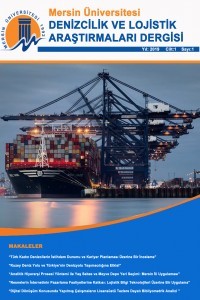Gemi Ana Makine Seçiminde Temel Faktörlerin Bulanık AHP Yöntemi ile Değerlendirilmesi
Gemi ana makine seçimi, geminin genel performansını, verimini ve işletme maliyetlerini etkilediği için gemi inşa sürecinde kritik bir karardır. Bu çalışmada Bulanık Analitik Hiyerarşi Sürecini (AHP) kullanarak gemi ana makine seçim kriterlerinin kapsamlı bir değerlendirmesi yapılmıştır. Bu yaklaşım, nitel ve nicel verileri içeren kriterleri göreceli önemlerine dayalı olarak değerlendirmek için sistemli bir çerçeve sunmaktadır. Ana makine seçiminde, ekonomik, teknik ve şirketle ilgili kriterler olmak üzere üç ana kriter belirlenmiş ve her bir ana kriter dört alt kriter ile detaylandırılmıştır. Sonuçlar, her bir alt kriterin göreceli önemini birlikte değerlendirildiğinde, yakıt tüketiminin genel önemin %17.01'ini oluşturan en yüksek öncelik olarak ortaya çıktığını göstermiştir. Bunu yakından takip eden makinenin kolay kullanımı ise %16,11'lik oranla ikinci sırayı alarak büyük önem arz etmiştir.
Anahtar Kelimeler:
Ana Makine Seçimi, Ticari Gemiler, Gemi İnşa, Karar Verme, Bulanık AHP
Assessing Key Factors in Marine Main Engine Selection using Fuzzy AHP Method
The main engine selection is a critical decision in the shipbuilding process, as it impacts the vessel's overall performance, efficiency, and operational costs. In this article, we present a comprehensive evaluation of marine engine selection criteria using Fuzzy Analytical Hierarchy Process (AHP). This approach provides a systematic framework for evaluating the criteria based on their relative importance, incorporating both qualitative and quantitative data. In the selection of the main engine, three main criteria were determined as economic criteria, technical criteria, and company-related criteria, and each main criterion was detailed with four sub-criteria. The results indicated that after considering the relative significance of each sub-criterion, fuel oil consumption emerged as the top priority, accounting for 17.01% of the overall importance. Following closely behind, easy operation held the second position with a rating of 16.11%, signifying its considerable importance.
Keywords:
Main Engine Selection, Merchant Ships, Shipbuilding, Decision-Making, Fuzzy AHP,
___
- Aguarón, J., Moreno-Jiménez, J.M.a. (2003). The geometric consistency index: Approximated thresholds. European Journal of Operational Research 147 (1), 137-145.
- Buckley, J.J. (1985). Fuzzy hierarchical analysis. Fuzzy sets and Systems 17 (3), 233-247.
- Bulut, E., Duru, O., Keçeci, T., Yoshida, S. (2012). Use of consistency index, expert prioritization and direct numerical inputs for generic fuzzy-AHP modeling: A process model for shipping asset management. Expert Systems with Applications 39 (2), 1911-1923.
- Bulut, E., Duru, O., Koçak, G. (2015). Rotational priority investigation in fuzzy analytic hierarchy process design: An empirical study on the marine engine selection problem. Applied Mathematical Modelling 39 (2), 913-923.
- Cebi, S., Ozkok, M., Kafali, M., Kahraman, C. (2016). A fuzzy multiphase and multicriteria decision-making method for cutting technologies used in Shipyards. International Journal of Fuzzy Systems, 18, 198-211.
- Celik, E., Akyuz, E. (2018). An interval type-2 fuzzy AHP and TOPSIS methods for decision-making problems in maritime transportation engineering: the case of ship loader. Ocean Engineering 155, 371-381.
- Chang, D.-Y. (1996). Applications of the extent analysis method on fuzzy AHP. European Journal of Operational Research 95 (3), 649-655.
- Crawford, G., Williams, C. (1985). A note on the analysis of subjective judgment matrices. Journal of mathematical psychology 29 (4), 387-405.
- Diesel, M. (2018). Basic principles of ship propulsion. Technical Report.
- Gürgen, S. (2021). Determination of ship main engine and establishment of optimum organic rankine cycle waste heat recovery system with artificial intelligence approaches, Department of Naval Architecture and Marine Engineering. Karadeniz Technical University, Trabzon, Turkey.
- Herişçakar, E. (1999). Gemi ana makine seçiminde çok kriterli karar verme yöntemleri ahp ve smart uygulaması. Gemi Inşaatı ve Deniz Teknolojisi Teknik Kongresi 99, 240-256.
- Kafalı, M., Özkök, M. (2015). Evaluation of shipyard selection criteria for shipowners using a fuzzy technique. Journal of Marine Engineering & Technology, 14(3), 146-158.
- Kahraman, C., Onar, S.C., Oztaysi, B. (2015). Fuzzy multicriteria decision-making: a literature review. International journal of computational intelligence systems 8 (4), 637-666.
- Kashav, V., Garg, C.P., Kumar, R., Sharma, A. (2022). Management and analysis of barriers in the maritime supply chains (MSCs) of containerized freight under fuzzy environment. Research in Transportation Business & Management 43, 100793.
- Kaya, I., Çolak, M., Terzi, F. (2019). A comprehensive review of fuzzy multi criteria decision making methodologies for energy policy making. Energy Strategy Reviews 24, 207-228.
- Mardani, A., Jusoh, A., Zavadskas, E.K. (2015). Fuzzy multiple criteria decision-making techniques and applications–Two decades review from 1994 to 2014. Expert Systems with Applications 42 (8), 4126-4148. Sahin, B., Senol, Y.E. (2015). A novel process model for marine accident analysis by using generic fuzzy-AHP algorithm. The Journal of Navigation 68 (1), 162-183.
- Sahin, B., Yip, T.L. (2017). Shipping technology selection for dynamic capability based on improved Gaussian fuzzy AHP model. Ocean Engineering 136, 233-242.
- Satty, T.L. (1980). The analytic hierarchy process. New York: McGraw-Hill.
- Sümeyra, U., Kazan, H. (2016). Çok kriterli karar verme yöntemlerinden AHP TOPSIS ve PROMETHEE karşılaştırılması: Gemi inşada ana makine seçimi uygulaması. Journal of Transportation and Logistics 1 (1), 99-113.
- Türk, A., Özkök, M. (2020). Shipyard location selection based on fuzzy AHP and TOPSIS. Journal of Intelligent & Fuzzy Systems 39 (3), 4557-4576.
- Türk, A., Özkök, M. (2022). Comprehensive Risk Assessment Analysis of Accidental Falls in Shipyards Using the Gaussian Fuzzy AHP Model. JEMS Maritime Sci 10 (4), 211-222.
- Van Laarhoven, P., Pedrycz, W. (1983). A fuzzy extension of Saaty's priority theory. Fuzzy sets and Systems 11 (1-3), 229-241.
- Watson, D.G. (1998). Practical Ship Design. Elsevier.
- Zadeh, L.A. (1965). Fuzzy sets. Information and Control 8 (3), 338-353.
- ISSN: 2687-6604
- Yayın Aralığı: Yılda 2 Sayı
- Başlangıç: 2019
- Yayıncı: Mersin Üniversitesi
